| Label :
|
"Marke" Weltmeister C.A. Wunderlich Siebenbrunn, Vogtl. D.R.P. 368379 D.R.G.M. 1137060 |
|
Model:
|
single F with pitch
correction |
|
Serial Number:
|
none |
|
Date of Manufacture:
|
After 1930 |
|
Key(s):
|
F |
|
Valves:
|
4 rotary plus 2 "correction" valves |
|
Bore:
|
|
|
Bell Flare:
|
|
|
Bell Throat:
|
|
|
Bell Diameter:
|
|
|
Base Metal:
|
yellow brass with nickel-silver trim |
|
Finish:
|
unlacquered |
| . (click on photos for larger view) |
|
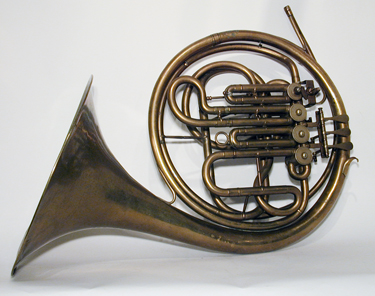 |
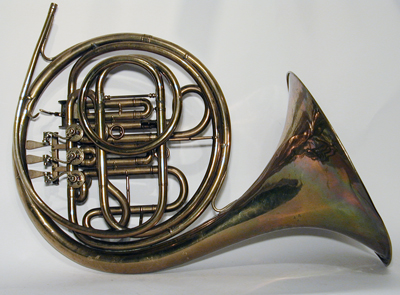 |
The firm of C.A. Wunderlich was established according to advertisement (see below) in 1854, and flourished in Siebenbrunn, Vogtland until about 1966. According to Dr. Enrico Weller it was established by Carl August Wunderlich (1826 - 1911) who was a skilled brass instrument maker.1 The family had also been long active as guitar and other string instrument makers. In 1909 it advertised as "factory for brass instruments and string, dealers in all musical instruments." Later it ceased manufacturing and went to "Herstellung in Heimat" (home-worker production), assuring its customers that that its products were not mediocre machine-made instruments, but rather they were hand-made by local artisans, although their names were never stated (see "Weltmeister" advertising, below). By the early twentieth century it became a very large dealer offering woodwind, brass, percussion, string instruments by catalog. Its patents included a metal bassoon and the "Normaphon" (a trumpet shaped like a tenor saxophone). |
|
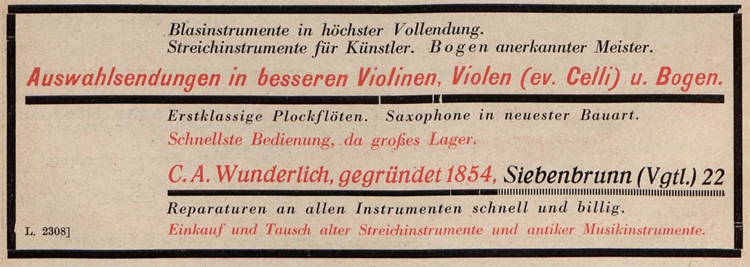 Zeitschrift für Instrumentenbau, October 1, 1930 |
|
The label on the bell (right) identifies this horn as part of the trademarked "Weltmeister" ("World Champion") line from C.A. Wunderlich (see catalog description, below). The label also shows two patent references. Deutsches Reichspatent (D.R.P.) 368379 issued to Julius Heubach2 on June 18, 1921. Heubach's patent was for an improvement to brass instruments to compensate for the fact that when valves are used in combination the resulting pitch will be sharp (see details, below). The second reference is to Deutsches Reichsgebrauchsmuster (D.R.G.M.) number 1137060, registered by C.A. Wunderlich in 1930. This gave Wunderlich basic copyright protection to market the horn for three years. Neither the design by Heubach nor the horn marketed by C.A. Wunderlich in 1930 was identical to the subject horn, although the principle is the same. According to Heyde (1987, p. 100) the design seen on this horn is due to Peter Hirsbrunner, Sumiswald, 1968, although this patent was derivitive of earlier designs3. (See detailed description of the design of the subject horn, below, and compare it with the Heubach patent.) |
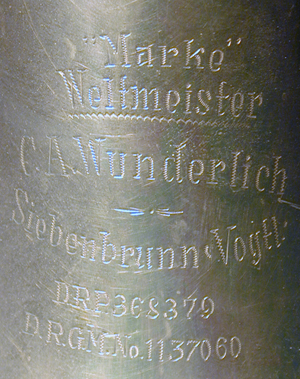 |
 C.A. Wunderlich Catalog, ca. 1930 |
|
As mentioned above, this horn corrects the problem commonly found on other valved brass instruments that causes the pitch of notes played with two or three valves to be sharp. This occurs because the valve slides are proportionate to the total length of the horn. For example the third valve slide is the proper length to lower the pitch of the open horn by 1½ steps (three semi-tones); the second valve lowers the open horn by one semi-tone, so the two valves in combination should lower the open horn by four semi-tones. With the added length of the third valve, however, the second valve is too short to lower the pitch a full semi-tone and the result is sharp. Similarly the combination of first and third valves or all three together is sharp for the same reason. Julius Heubach solved the problem with two additional "correction" valves that are automatically opened when the third valve is pressed, adding length to the first and second valves. This is accomplished with a complex series of arms linked to the third valve rotor (see patent diagram, below right) and was implemented on the horn originally marketed by C.A. Wunderlich, ca. 1930 (see catalog entry, below left). |
|
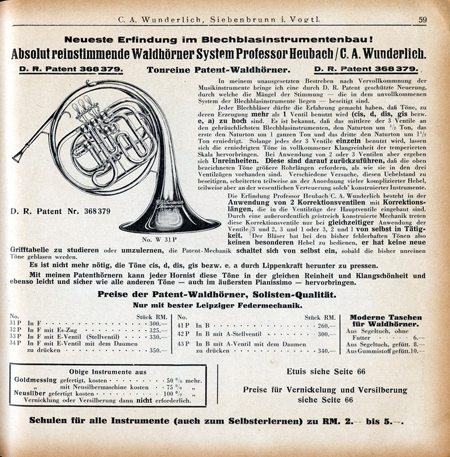 C.A. Wunderlich catalog, ca. 1930 |
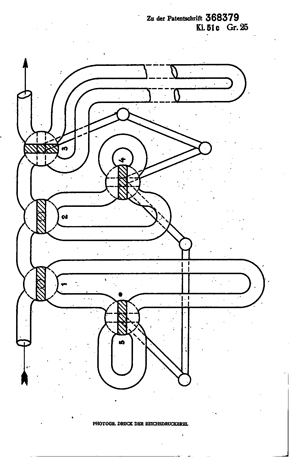 Drawing for Heubach Patent, June 18, 1921 |
The present horn eliminates the secondary "correction" valves and levers by ingeniously routing the third valve slide to a second row of valve ports, similar to the valves on a double horn. As seen from the player's side in the photo at right, the "correction" valve slides are visible on the lower level of the first and second valve rotors. Superimposed is a diagram (red) showing the air path when the second and third valves are pressed. Following the air path in this example starting from the top of the valve section, the second valve is opened to its primary (longer) slide in the usual way. The path then continues through the third valve into its slide. Instead of returning directly to the third valve rotor, however, the path returns to the top of the valve section into the lower rank of the valve rotors. It then passes through the "correction" slide of the second valve before being routed out to the first branch and bell. If the third valve is not pressed then the path is only through the upper rank of the valve set in the usual way, and directed into the first branch through the small loop on the third valve, as shown in green. |
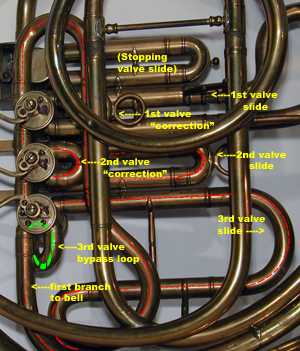 |
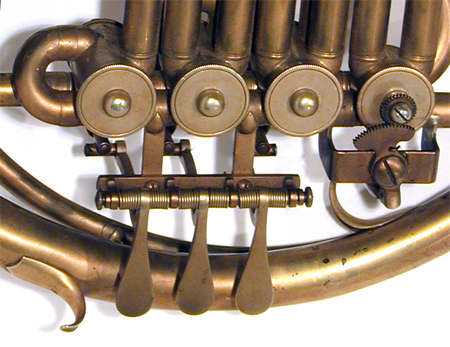 |
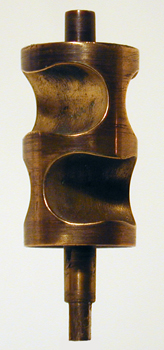 |
The photo above left shows the valve set from the front of the horn. Clearly visible is the loop on the third valve that routes the air path to the first branch when the valve is not pressed. The unusual rotor core for the third valve is shown in the photo at right. It has two sets of ports (upper and lower) similar to a normal double horn rotors, however they are at right angles to each other which accomplishes the routing of the air path to the second level of the valve set. To the right of the first valve is a fourth half-step valve operated by the player's thumb valve that is used when playing "stopped" notes. It has a very unusual geared linkage which can be quite noisy. |
|